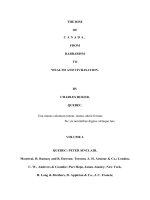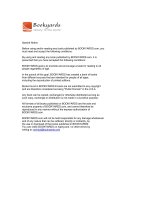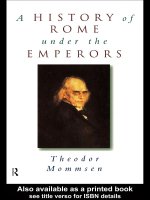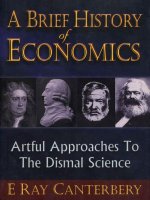A history of macroeconomics from keynes to lucas and beyond
Bạn đang xem bản rút gọn của tài liệu. Xem và tải ngay bản đầy đủ của tài liệu tại đây (15.36 MB, 448 trang )
'Michel De Vroey does not simply record what he finds. He has a vision of the kind of
macroeconomics he would like to see. perhaps one he has developed gradually over the
years he has worked on this book. What makes this book enjoyable is that he has high
hopes for economics, he flatters us that we are important, and he praises the progress
we have achieved. In the end. he has the integrity not to hide tus disappointments, his
conviction that, while there is no tuming back, there is still a long way to go.'
Robert E. Lucas, Jr., Jolm Dewey Distinguished Service Professor in
Economics, University of Chicago
'No branch of economics has witnessed as many revolutions and counter-revolutions as
macroeconomics, staning from Keynes' General Theory 80 years ago. Michel De Vroey's
book provides a thorough but highly readable account of the main developments in
the field over that period. It conveys a sense of the excitement generated by the advent
of every new paradigm, as well as of the growing tension between the requirements of
theoretical purity and those of empirical and policy relevance that macroeconomists
keep facing these days.'
Jordi Gali, CREI, Universitat Pompeu Fabra and Barcelona GSE
'Macroeconomics research has largely proceeded through "revolutions." One wishes
for a more linear and evolutionary process. one where most new contributions would
naturally fit. and the corrunon core become steadily stronger. But the immense
complexity of modero economies. the difflcult methodological choices, may be such
that "revolutions" will keep happening, with their share of destruction, corúusion and
eventual reconstruction. Understanding the nature of these revolutions is essential to
understanding where we are today. and Michel De Vroey's book does a masterful job
of doing just that. A thoroughly illurninating and enjoying read.'
Olivier J. Blanchard, Robert M. Solow Professor of Economics.
Massachusetts lnstitute ofTechnology
'Macroeconomics is a complex evolving system of thinking. Michel De Vroey's Iatest
book dives into that evolving complexity anci, by distinguishing between Marshallian
and Walrasian macroeconomics, helps make the history of macroeconomics a bit more
understandable. It's sad that more economists don't make that distinction.'
David Colander, Distinguished College Professor, Middlebury College
Mlcbel De Vroey is a professor emeritus
at the Université catholique de Louvain and
visiting professor at the Université Saint Louis
in Brussels. He has published severa! books,
including Involuntary Unemployment: The Elusive
Quest tora Theory (2007) and Keynes, Lucas:
D 'une macroéconomie a l'autre (2009). He has
also published extensively in scholarly journals.
Cover design: Atice Soloway
ISBN 978-1-107-58494-5
1111111111111 >
9 781107 584945
www.ebook3000.com
A History of Macroeconomics from Keynes to Lucas and Beyond
This book retraces the history of macroeconomics from Keynes's
General Theory to the present. Central to it is the contrast between
a Keynesian era and a Lucasian - or dynamic stochastic general
equilibrium (DSGE) - era, each ruled by distinct methodological
standards. In the Keynesian era, the book studies the following
theories: Keynesian macroeconomics, monetarism, disequilibriurn
macroeconomics (Patinkin, Leijongufvud, and Clower) non-Walrasian
equilibrium models, and first-generation new Keynesian models. Three
stages are identified in the DSGE era: new classical macroeconomics
(Lucas), RBC modelling, and second-generation new Keynesian modelling. The book also examines a few selected works aimed at presenting
alternatives to the Lucasian macroeconomics. While not eschewing
analytical content, Michel De Vroey focuses on substantive assessments, and the models studied are presented in a pedagogical and vivid
yet critica! way.
Michel De Vroey is a professor emcritus at the Université catholique de
Louvain and a visiting professor at the Université Saint Louis in Brussels. He held visiting positions at the Sorbonne University, Duke University, the University of British Columbia, Vancouver, and Clemson
University. He has published severa! books, including Involuntary
Unemployment: The Elusive Quest for a Theory (2007) and Keynes,
Lucas: D'une macroéconomie á l'autre (2009). He has also published
extensively in scholarly journals.
www.ebook3000.com
/
www.ebook3000.com
A History of Macroeconomics from
Keynes to Lucas and Beyond
MICHEL DE VROEY
Université catholique de Louvain, Belgium
~CAMBRIDGE
9
UNIVERSITY PRESS
www.ebook3000.com
CAMBRIDGE
UNIVERSITY PRESS
32 Avenue of the Americas, New York, NY roor3-2473, USA
Cambridge University Press is part of the University of Cambridge.
It furthers the University's mission by disseminating knowledge in the pursuit of
education, learning, and research at the highest internationallevels of excellence.
www.cambridge.org
Information on this title: www.cambridge.org/9?80521898430
© Michel De Vroey 2016
This publication is in copyright. Subject to statutory exception
and to the provisions of relevant collective !icensing agreements,
no reproduction of any part may take place without the written
permission of Cambridge University Press.
First published
2016
Printed in the United Kingdom by Clays, St Ives pie.
A catalog record for this publication is available from the British Library.
ISBN 978-0-521-89843-0 Hardback
ISBN 978-r-107-58494-5 Paperback
Cambridge University Press has no responsibility for the persistence or accuracy
of URLs for externa! or third-party Internet Web sites referred to in this publication,
and does not guarantee that any content on such Web sites is, or will remain,
accurate or appropriate.
www.ebook3000.com
To ]ean Cartelier, Marie-Paule Donsimoni, Franco Donzelli, and
Laurent d'Ursel, who helped me shape my vision of economic theory
www.ebook3000.com
1
1
1
1
1
1
1
1
1
1
1
1
1
1
1
www.ebook3000.com
1
Contents
List of Figures
List of Tables
Boxes
Preface
Acknowledgements
page ix
XI
xii
xiii
XIX
PART 1: KEYNES AND KEYNESIAN MACROECONOMICS
1
Keynes's General Theory and the Emergence of Modern
Macroeconomics
2
3
4
5
6
7
8
Keynesian Macroeconomics: The IS-LM Model
The Neoclassical Synthesis Program: Klein and Patinkin
Milton Friedman and the Monetarist Debate
Phelps and Friedman: The Natural Rate of Unemployment
Leijonhufvud and Clower
Non-Walrasian Equilibrinm Modeling
Assessment
3
27
50
65
95
II2
123
143
PART ll: DSGE MACROECONOMICS
9
ro
rr
r2
Lucas and the Emergence of DSGE Macroeconomics
A Methodological Breach
Assessing Lucas
Early Reactions to Lucas
13 Reacting to Lucas: First-Generation New Keynesians
151
174
191
204
225
vii
www.ebook3000.com
Contents
Vlll
14 Reacting to Lucas: Alternative Research Lines
r 5 Real Business Cycle Modeling: Kydland and Prescott's
Contribution
r 6 Real Business Cycle Modeling: Critica! Reactions and
Further Developments
17 Real Business Cycle Modeling: My Assessment
r8 Second-Generation New Keynesian Modeling
PART Ill: A BROADER PERSPECTIVE
r 9 The History of Macroeconomics through the Lens
of the Marshall-Walras Divide
20 Standing up to DSGE Macroeconornics
21 Looking Back, Looking Ahead
Bibliography
Index
www.ebook3000.com
247
261
299
307
Figures
r.r
1.2
r. 3
2.1
2.2
2.3
2.4
2. 5
2.6
2. 7
2.8
2.9
3.1
3.2
4.1
5.1
5.2
5·3
6.r
7.1
8.1
Temporary and normal equilibrium: Marshall's fish market
page rr
The firm's output decision
r7
The determination of effective demand
r9
Equilibrium in the IS-LM model
28
The Keynesian LM curve according to Hicks
29
Contrasting two definitions of rigidity
31
The lack of equilibrium between saving and investment at
full-employment in come, according to Klein
35
The labor market outcome
36
The Phillips relationship
42
The discrepancy between the Phillips relation and the
Phillips curve
43
Integrating involuntary unemployment and frictional
unemployment
44
The Phillips curve
45
The commodity and labor markets in equilibrium
6o
The commodity and the labor markets in disequilibrium
6r
Velocity in the US Economy
91
Relations between vacancy and unemployment rates
99
Phelps's expectations-augmented Phillips curve
ror
The accelerationist view of the Phillips curve
ro4
Involuntary unemployment as resulting from a signaling defect
121
The Keynesian regime
126
A decision-tree representation of the early years of
macroeconomics
147
13.1 Involuntary unemployment in the shirking model
13.2 The profit function of a monopolistic firm
13.3 The labor market short-period normal equilibrium
230
237
241
ix
www.ebook3000.com
X
1 3·4
List of Figures
Jnconsistent claims
Labor market disequilibrium and inflationary dynamics
14.1 Different levels of activity in Diamond's searcb model
14-2 The trade structure in Roberts's model
15.1 TFP and real GDP
18.1 The Dixit-Stiglitz monopolistic competition model
19.1 Marshall's breakdown of the economy into separate elements
19.2 Marshall's fishing industry example
19.3 Walras's strategy for dealing with complexity
20.1 Effective demanda la Keynes and a la Farmer
20.2 The determination of output
13.5
242.
243
250
257
270
312
342
342
343
3 66
367
Tables
o. r The main episodes in the history of macroeconomics
page xv
4-I The evolntion from Friedman's expectations-augmented
Phillips Curve model to Lucas's and Kydland and
93
Prescott's models
6.r The commonalities and differences between Patinkin,
Clower, and Leijonhufvud
XI3
7.r A typology of non-Walrasian equilibrium states
137
8.r Alternative views of the Keynesian program
144
xo.r Comparing Keynesian and new classical macroeconomics
187
2.52
14.1 Comparing the Lucas and the Diamond approaches
r5.r Kydland and Prescott's main results
2.65
r8.r The differences between first- and second-generation new
Keynesian modeling strategies
309
r8.2. The new Keynesian-RBC synthesis
32.6
r9.r The Marshallian and the Walrasian approaches: contrasts
and commonalities
340
19.2. A comparison of the Keynesian and the DSGE programs
348
19.3 Lucas's neutrality of money modelas an amended Walrasian
two-good exchange model
3 52
19.4 Classifying macroeconomic models against the Marshall-Walras
divide
356
2r.r Claims made about labor market outcomes
381
2.r.2 Classifying models against the requirement for fui! general
equilibrium analysis
3 84
21:3 A typology of macroeconomic models in the I970s
386
2.r.4 The policy conclusions of the models
3 86
xi
Boxes
o.r A snapshot account of the history of macroeconomics
r.r Marshall's equilibrium triad versus the post-Marsballian
equilibrium dyad
9.1 The notion of intertemporal elasticity of substitution
r2.r The VAR approach
rs.r The Solow residual
r 8.r The Dixit-Stiglitz monopolistic competition model
xii
page xvii
Preface
To know who we are, we need to know where we come from.
The aim of this book is to trace the evolution of modern macroeconomics from
its inception to the present. A sufficient justification for this enterprise is
that modern macroeconomics, which originated with the publication of John
Maynard Keynes's The General Theory of Emp/oyment, Interest, and Money
(Keynes 1936), has now existed long enongh to make it worth assessing what
has happened over the past seventy years. An additional justification is that
during this period macroeconomics has undergone a radical change with the
dethroning of Keynesian macroeconomics and its replacement by dynamic
stochastic macroeconomics initiated by Robert Lucas. This revolution begs to
be assessed. In Axel Leijonhufvud's words:
The main task for the history of economic thought of the second hall of the rwentieth
century must surely be to explain this I8o-degree turn in the worldview of the representative [macro] economist. (Leijonhufvud 2oo6a: 35)
M y book is primarily addressed to those macroeconomists, be they teachers or
students, who feel the need to go beyond the technicalities that provide their
daily bread and butter, and wish to pender the origin of the kind of modeling
with which they are familiar. My wish is that it might be especially useful to
graduate students and young academics. Their training is often purely technical
and centered on the models of the da y, as if there had been no useful past, and
as if no conceptual or methodological problems inherited from the past still
had an influence today. Of course, this book is also addressed to historians of
economics, be they doing interna! history, as 1 do, or working from an externa!
history perspective. Final! y, 1 hope that it will be useful to economists working
in other branches of the discipline who are curious to learn what has happened
in their neighbors' yards.
xiii
XIV
Preface
My essay originated from a teaching experience. For more than twenty
years, I ha ve been teaching a graduate course on the history of rnacroeconomics
mainly at my own university (the University of Louvain in Belgium) but also, in
the past, at the Sorbonne in París and at Duke University. In this seminar-like
course, 1 require students toread a series of seminal works spanning the history
of macroeconomics frorn Keynes to the present.' Usually students enjoy reading
these texts for the simple reason that they represent a refreshing change from
tbeir normal curriculum. At each reading, they tend to be convinced by the
author's arguments befare often realizing these authors' shortcomings and
blind spots at the next reading. 1 genuinely relish helping them discover that
macroeconomics is full of disagreements bearing both on argumentation and
policy conclusions. This approach is more congenia! to me than the conventional view of monotonic progress. Of course, students change every year, but
1 repeat the course - so 1 ha ve read sorne of these texts about twenty times!
Surprisingly enough, 1 bave not become bored with them, a sure testimony to
their profundity. Actually, for sorne authors, in particular Lucas and his followers, returning to them frequently has been a good thing: due to my own
prejudices and the counterintuitive nature of their thinking, it took me a long
time to fully appreciate their contributions.
The history of modern macroeconomics has been witness to two important
breaches. The first relates to the transition from what Keynes wrote in The
General Theory to what it became in the hands of Keynesian economists in
Leijonhufvud's terms, the transition from the 'Economics of Keynes' into
'Keynesian Economics' (1968).' The second one was the 'Lucasian revolution,'
which swept away Keynesian macroeconomics. Thus, leaving aside Keynes's
General Theory proper, the history of macroeconomics can be divided into two
eras, the first one, roughly extending from the 1940s to the 1970s, during which
"Keynesian rnacroeconomics" held sway, and the era of ''DSGE macroeconomics" DSGE standing for dynamic-stochastic general equilibrium- that started
in the mid-X97os and is still the dominant paradigm.
To give a more detailed account, Keynes's aim in The General Theory was to
demonstrate the existence of involuntary unemployrnent under the assumption
that wage rigidity was not responsible for it. The first generation of Keynesian
economists, led by John Hicks Hicks, Franco Modigliani, and Lawrence Klein,
admitted to all intents and purposes that Keynes had failed in his enterprise and
1
These include a few chapters of the General Theory; Hicks's IS-LM paper; chapters Xill and XIV
of Patinkin's Money, lnterest and Prices; Clower's 1965 article; Barro and Grossman's 1971
article; Friedman's 1968 Presidential Address; Lucas's "Understanding Business Cycle" and
"Problems and Methods in Business Cycle Theory" articles; one or two new Keynesian pieces;
Prescott's Nobel Prize lecture; and a few more recent pieces.
~ Leijonhufvud contended that there was a significant discrepanL)' between the content of the
General Theory (the Economics of Keynes) and what it became in the hands of Keynesian
economists.
Preface
TABLEo. r
XV
The Main Episodes in the History of Macroeconomics
Episodes
Main Characters
Keynes's General Theory
Keynesian (or
IS~LM)
macroeconomics
Keynes
Hicks, Modigliani, Klein
Monetarism
The invention of the natural rate of
unemployment
Disequilibrium theory
Non-Walrasian equilibrium models
Friedman
Phelps, Friedman
DSGE 1: Lucasian macroeconomics (or
'new classical macroeconomics' or
Lucas, Sargent, Wallace, Barro
Patinkin, Clower, and Leijonhufvud
Barro and Grossman, Benassy, Dráe,
Malinvaud
'rational expectations revolution')
First generation of new Keynesian
modeling
Alternative research lines
DSGE Il: RBC modeling
DSGE III: second generation of new
Keynesian modeling
Akerlof, Azariadis, Ball, Blanchard,
Fischer, Mankiw, Romer, Shapiro and
Stiglitz, Solow, Taylor
Carlin and Soskice, Diamond, Hart,
Roberts,
Kydland and Prescott
Blanchard, Christiano, Eichenbaum and
Evans, Gali, Taylor, Rotemberg, Smets
and Wouters, Woodford
argued that involuntary unernployrnent was dueto wage rigidity. This proposition is the cornerstone of Keynesian rnacroeconomics, centered on the IS-LM
model. In the late r96os and I97os, Leijonhufvud and non-Walrasian equilibrium econornists (following Don Patinkin's footsteps), on the one hand,
and Edrnund Phelps and Milton Friedman, on the other, started to question Keynesian rnacroeconomics in different ways and for different reasons.
Treading in Friedrnan's and Phelps's footsteps, Robert Lucas launched a more
radical attack against Keynesian macroeconomics. lt led to a new approach,
DSGE rnacroeconomics. An occurrence that had all the trappings of a Kuhnian
scientific revolution, it sealed the fate of Keynesian rnacroeconomics. However,
the ascent of the DSGE program did not occur without resistance. Defenders of
Keynesian macroeconomics dismissed it on the grounds that it amounted to
replacing "messy truth by precise error" (Lipsey 2ooo: 76). Other economists,
who rallied under the 'new Keynesian' banner, tried to rescue sorne Keynesian
insights, while espousing the new equilibrium standard Lucas had imposed.
The new research program inaugurated by Lucas carne to fruition with the
ernergence of real business cycle (RBC) modeling initiated by Finn Kydland
and Edward Prescott. Bringing rnacroeconomics to the computer, it became
the be-al! and end-all of the young researchers entering the profession in the
mid-r98os. Successive rnodifications of the inaugural RBC model brought
XVI
Preface
about the realization that a breach had irnperceptibly occurred and that a
distinct new way of pursuing the Lucasian prograrn had emerged. For reasons
that will becorne clear in the course of the book, 1 cal! it 'second-generation new
Keynesian' rnodeling. Although they are built on the rnethodological principies
of the DSGE prograrn, these rnodels depart frorn RBC rnodeling by bringing
back a few central Keynesian assurnptions and resorting to other ern pirical
techniques than those of RBC rnodelers. Second-generation new Keynesian
rnodeling was the state of the art in rnacroeconornics at the onset of the 2008
recession. Table o.r and Box o.r cornplernent this surnrnary.
Box o. r hints at what will be a guiding thread in my analysis, Leijonhufvud's
decision-tree metaphor for the history of macroeconomics:
Major economists force thejr contemporaries to face choices - the choice of what to
ask) what to assume, what to regard as evidence and what methods and models to
employ - and persuade the profession or sorne fraction of it to follow the choice
they make. The path that any part~cular school has followed traces a sequence of
such decisions. Many of the choices faced in such a sequence were not anticipated by
the founder to which we trace the development in question but were created by sub~
sequent contributors; sorne of the decisions made we may judge to have been wrong
in hindsight. (Leijonhufvud 1994' 148)
Any majar bifurcation on the tree, that is, a new research line, starts as an
original contribution, which in the beginning is like a thin new branch on a
tree. lts success hinges on the attention it receives. The original work must be
considered sufficiently interesting to be elaborated on, and the ensuing chain
of contributions building on each other is what makes the branch sturdy.
Once mature, a research track rnay gradually lose its momentum: puzzles arise,
objections are leveled, and doubt about its validity sets in. Leijonhufvud calls
what occurs then 'backtracking,' that is, traveling back clown the decision tree
to an earlier bifurcation that at the time was neglected but now seems a viable
and appealing alternative. When this backtracking process goes back all the
way toa distant decisional node, as happened with Lucas, it is tantamount toa
scientific revolution.
M y study focuses on what I view as the most salient episodes in the history
of rnacroeconomics. 1 do not claim that it is exhaustive. 1 ha ve chosen to give
more emphasis to theoretical aspects than to empirical ones. My work is
interna! history and leaves aside most of the contextua! dimension. I deal
neither with pre-Keynesian macroeconomics nor with heterodox theory. 3
Moreover, although macroeconomics as it is understood at present encompasses both growth and business fluctuations, I will say nothing about the
former for the simple reason that writing its history would require a book of
3 For a study of pre-Keynesian macroeconomics, see La.idler ('r999) and Dimand (2oo8b) For a
study of heterodox macroeconomics, see King (2002) and Fine and Milonakis (2oo8).
Preface
BOX
xvii
o.x A snapshot account of the history of macroeconomics
The General Theory
(Chapta /)
1\
Keynesian macroeconomics:
Reappraisats
Hicks, Modigliani, Klein
and Goldberger (Chapter 2)
1 \
Patinkin
Clower and
(Chapter 3)
Leijonhufvud
(Chapter 6)
~ ~"TE::1helps
~
\ /
Non-Walrasian
equilibrium
First generation New
models ( Chapter 7) Kcynesian models
( Chapter 13)
}
\
Altemative research lines
(Chapter 14)
(Chapter5)
DSGE~
macroeconomics
First wave: new
~ classical model
(Chapters 9-11)
t
Second wave: RBC
models (Chapter 15-17)
~
Third wave: second generation
New Keynesian models
( Chapter 18)
A single-headed arrow indicates a relation of continuity, a double-headed arrow arelation of opposition
its own. I apologize to growth theorists for using the macroeconomics generic
term for designating only one of its cornponents, namely the study of business
fluctuations.
lt is not the role of a historian of econornics to decree what the research
agenda should be. Nonetheless, I will not refrain from expressing rny personal critica! judgments about the various economists 1 study. This should
not be taken as a sign of arrogance. lt is merely that the history of economic
analysis is a via negativa - engaging in it amounts to a large extent to
critiquing past authors. 1 arn, of course, aware that the older a theory, the
easier it is to detect its blind spots. lt bears repeating that that my paramount
feeling about the authors 1 study is one of admiration, even when 1 am
critiquing them.
XVlll
Preface
Severa! excellent surveys of the history of macroeconornics are available, but
they are rnainly articles, with the ensuing lirnitations.4 There are also a few
books: Hoover (r988), Snowdon, and Vane (2005) and its precursor, Snowdon, Vane, and Wynarczyk (1994), and, more recently, Backhouse and Boianovski (2or 3 ). Still, much remains to be said, and 1 hope that this book, the
result of about a decade of research, will open new perspectives.
4
E.g., Blanchard (¡990, wooa, 2.008), Colander (wo6), Hoover (2003), Leijonhufvud (20o6a}
Mankiw (1990, 1992a, :r992b, 2006), Woodford (r999, 2009).
Acknowledgements
During the many years that I ha ve been working on this book, I ha ve benefitted
from many encouragements and comments. First of all, I wish to express my
gratitude to the generations of students who, without realizing it, have helped
me shape the views expressed in this book. Special mentían must be made of a
group of doctoral students from my Louvain 2014 Spring course, whose
assignment was to read this book's manuscript critically: Hamze Arabzadeh,
Sotiris Blanas, Stéphane Bouché, Andreas Gregor, Joel Machedo Carneiro,
Guzman Ourens Brocas, Pierre Pecher, Francesco-Andrea Pir.rone, Eliza Rizzo,
and Eric Roca Fernandez. I am also grateful to my coauthors (and friends)
Anna Batyra, Samuel Danthine, Pedro Garcia Duarte, Pierre Malgrange, and,
in particular, Luca Pensieroso for our discussions on the tapie of this book. M y
gratitude also extends to severa! other colleagues who read part of this manuscript or exchanged ideas about it: Roger Backhouse, Georges Bastin, JeanPascal Benassy, Alain Béraud, Mauro Boianovsky, David Colander, Fabrice
Collard, Antaine d' Autume, David de la Croix, Charlotte De Vroey, Ghislain
Deleplace, Robert Dimand, Jacques Dreze, Jean-Fran<;ois Fagnart, Paula Gobbi,
Liam Graham, Kevin Hoover, Frédéric Jouneau, Ludovic Julien, Philippe Le
Gall, Goulven Rubín, Aurélien Saidi, Francesco Sergi, and many others. I am also
thankful to Karen Maloney and the staff of Cambridge University Press for their
patience and availablity. Finally, 1 wish to express my gratitude to Hélene Windish. She started helping me by editing my English and ended up acting as an
invaluable coach and friend.
Figure 4.1 "Velocity in the U.S. Economy" is drawn from FRED with
permission of the Federal Reserve Bank of St. Louis.
Figure 6. r "Involuntary unemployment as resulting from a signaling defect"
is drawn from Clower. "The Keynesian Counterrevolution: A Theoretical
xix
www.ebook3000.com
XX
Acknowledgements
Appraisal" in F. Hahn and R. Brechling (eds). The Theory of Interest
Rates (1965) with the permission of Macmillan Subrights Department.
Figure 13.2 "The profit function of a monopolistic firm" is drawn from
Foundation of Modern Macroeconomics by B. Heijdra and F. Van der
Ploeg (2002) with the permission of Oxford University Press.
Figure 14. r "Different levels of activity in Diamond's search model" is
drawn from Diamond, P. "Aggregate Demand Management in Search
Equilibrinm." ]ournal of Political Economy, vol. 90, 1992 with the permission of the University of Chicago Press.
Figures 20.1 "Effective demand ií la Keynes and ií la Farmer" and 20.2, "The
determination of output" are drawn from Expectations, Employment and
!'rices by Roger Farmer (2010) with the permission of Oxford
University Press.
PART l
KEYNES AND KEYNESIAN MACROECONOMICS
I
Keynes's General Theory and the Emergence of
Modern Macroeconomics
When a modern economist reads The General Theory, the experience is both
exhilarating and frustrating. On the one hand, the book is the work of a great
mind being applied to a social problem whose currency and enormity cannot
be questioned. On the other hand, although the book is extensive in its analysis,
it somehow seems incornplete as a matter of logic. Too many threads are left
hanging. The reader keeps asking, what, precisely, is the econornic model that ties
together al! the pieces? (Mankiw 2006: 31)
M y study must start with John Maynard Keynes's book, The General Theory
of Employment, Interest, and Money (1936). Before writing it, Keynes was
already internationally famous, a towering figure in the economics profession,
as well as in policy decision making in the United Kingdom, but this book
definitively placed him in the pantheon of great economists.' Although he had a
solid reputation among academics, for a long time Keynes's main activity was
providing expertise on monetary matters to the British government and international organizations. The Treatise on Money (Keyries 1930) was his first
important foray into high theory. Sadly, Keynes's great hopes for this book
were not fulfilled. Soon recognizing its flaws, he started working on what was
to become The General Theory.
Keynes's aim in writing this book was to identify the causes of the mass
unemployment that affected al! developed economies in the Great Depression
years. The I930s were also a time during which Russia was witnessing strong
economic results to the effect that a possible electoral victory of parties leaning
toward communism (or their taking power in more unorthodox ways) was a
1
Two renowned biographies ofKeynes are Moggridgc's (.r992) and Skidelsky's three-volume work
(r983, 1992, and 2ooo).
3
A History of Macroeconomics from Keynes to Lucas and Beyond
4
possibility that could not be discarded. In short, capitalism was in peril, both
economically and politically, and Keynes realized that its survival implied
importan! changes in its functioning. As noted by Robert Skidelsky, the task
ahead intertwined theory and persuasion:
Keynes understood that his theory had to be usable for politicians and administrators: easily applied, offering politícal dividends. But he also understood that, befare
he could win the political argument, he had to win the intellectual argument. (Skidelsky
1992: 344)
The main diagnosis about the crisis available to economists at the time was of
"Austrian" inspiration. The crisis, the story ran, signaled a situation of overinvestment and misallocation of resources, a state of affairs that required for its
solution a process of 'liquidation,' a real wage deflation, on the one hand, and
sorne sanctioning of the firms that had engaged in wrong investment decisions,
on the other. Flexibility was thus the motto. The more flexible prices and wages
were, the faster the liquidation process would come to an end and conditions
for prosperity would be reestablished. However, when the depression kept its
course without wages deflation exerting its proclaimed effect, economists
started to waver about the virtues of laissez-faire and to wonder whether, this
doctrine to the contraty notwithstanding, governments should engage
more actively in the economy. Thus, economists were torn between the policy
conclusions following from accepted theory and their gut feeling that another
path should be taken. Keynes's project was to remove this contradiction by
providing a theoretical argument in favor of the gut feeling. The General
Theory ensued.
lt was received enthusiastically - greeted as a "liberating revelation" in
Leijonhufvud's words (1968: JI) - especially by young economists. 2 There
were a few dissenting voices, focusing on the shortcomings of Keynes's
reasoning, but the pressure to produce a new theoretical framework that might
account for the obvious dysfunctions in the market system was such that they
did not gain much traction. Keynesian theory took off rapidly. As a paradigm,
it held sway until the 1970s when it carne under strong attack, first by Friedman
and Phelps and then by Lucas.
Toda y, Keynes's theory is divisive. In the wake of the 2.oo8 recession, after
more than two decades during which Lucasian macroeconomics held sway,
many economists have claimed the need to return to the master (Skidelsky
2.009 ). In terms of Leijonhufvud's decision-tree image, this irnplies a long,
drawn-out backtracking process, a return either to square one (The General
:t
"One of the exciting things, of course, for a nineteen~year old was the sense of intellecrual
revolution, overturning the obsolete wisdom encrusted in the past, especial!y when the new
theory was on the side of promising to do something constructive about the main problems that
concerned me and peoplc of my generation" (Tobin's intervieW with Snowdon and Vane [r993l
2005: X49l·









